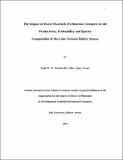The Impact of Water Hyacinth (Eichhornia Crassipes) on the Productivity, Profitability and Species Composition of the Lake Victoria fishery, Kenya
Author
Date
2003Type
Articleviews
downloads
Metadata
Show full item recordxmlui.dri2xhtml.METS-1.0.item-citation
Doctor of Philosophy in Environmental Studies(Enviromental Economics) Moi University, Eldoret- Kenya
Abstract/
One of the sectors gravely hampered by water hyacinth (WH) on L. Victoria (Kenya) is the fishery sector. This has prompted the need to develop an approach for modeling impacts of WH on fish production. The main objective of this study was assessing the impact of (WH) on production and fish species composition on the L.Victoria fishery (Kenya). It was postulated that WH infestation has led to reduced fish catch, net benefits and change in fish species composition. Cost benefit analysis (CBA) provided information on the net benefits of fishing with and without WH, while Production functions (PF) were used to establish determinants of fish production using cross sectional data. Error Correction Models (ECM) used beach sample times series data (1990-2000) to assess the effect of WH, climate and fish prices on the major L. Victoria fisheries, while Vector Auto regression (VAR) models were used to measure the effects of fish price and WH intensity on fish species composition of L. Victoria (1986-2000). The results showed that WH intensity was highest between 1996-1999 and increased fishing costs by 35% and decreased net income by 52%. The PFs identified fishing crew, boat size and WH as having significant effects on fish catch and income. Both the PF and ECM results indicated that WH had a negative and positive effect on the Tilapiines and mixed fish respectively. In the short run ECM results indicated that both rainfall and price had less significant effect on catch per unit effort (CPUE) in all fisheries. However, in the long run price had significant impacts in most of the fisheries as compared to the rainfall factor. Trends in the fish species composition indicated an increase in the mixed Tilapiines and Protopterus while there was a decline in the R. argentea and Mormyrus. The impulse response analysis indicated that a 10% shock in WH led to a decline of fish catch for R. argentea (1.5%) and an increase in Protopterus (8%), Mixed Tilapiines (10%) and Haplochromis (2%). Generally, the prices moved in the same direction with the catch and then changed to opposite direction as from the third year. Since the benefits of WH are realized on the non-commercial fish species but little or negative on the three major commercial species, there is need to develop a suitable surveillance and control system for WH in order to keep this weed below economic injury levels The CBA, PF, ECM and VAR models were recommended for impact assessments of WH on fish productivity, net benefits and fish species composition. The choice of each will depend on the objectives of the study and data availability.

